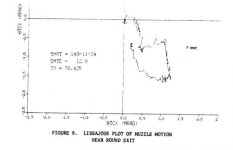T
tim in tx
Guest
Tim Calfee has tried the weight behind the muzzle as is popular in centerfire were weight is a major issue.He went with lighter barrels and the tuner out in front for a very specific reason.
The reason is simply so the barrel will flex and bend more .In a physical sense the barrel can only flex more when weight is added from the forces created on it which ultimately is creating more vertical angular dispersion at the muzzle and less linier dispersion Keith spoke of by making the weak spot just behind the crown about 1 inch back.This is what I am doing and is the only way to correct large velocities and now every thing in between as well,and out in front gives a given weight more leverage to do that and the correct weight in the correct distance from the muzzle will do that .It will point the muzzle up when the area just behind the muzzle is forced down effectivly causing lagging behind or a tip up ,every barrel has this tip up weighted or not and behind the muzzle or in front ,but by adding weight in front we are just making it bigger and timing the exit properly out in front just plain and simply makes it flex enough for the distances we are shooting. For example: In a few weeks we will be trying some large velocity corrections at 1 mile and possibly longer and in front is the only way to get enough correction or bending to go the mile. I know this is possible because I can get a bullet 120fps slower to hit a good 1 moa higher then the faster of the 2 at 1000yds and repeatedly .The fact that I can overcorrect in the adjustment at 1000yds shows there is still plenty of correction left in the bending and that I could converge them out to longer distances with at least 60 fps ,this is a heavy straight taper,brake/ adjustable tuner with plenty of recoil force to make this work . But less recoil force as in rimfires takes more extremes to flex or bend the barrel and center of gravity at only 1 inch below the centerline does not help any either .That is why Bill must hang over the end on rimfires.On genes behind the muzzle the bending or width of tune is narrower then a forward weighted which is iirelivant since you can adjust and keep a precise tune through out the day. but if he were to be shooting 1000yds he would have to make the barrel bend more for more correction either by going to a skinny barrel or adding weight in front of the crown to have enough correction for 1000yds . So my point is it depends on how much do you need the barrel to bend.
Tim in Tx


